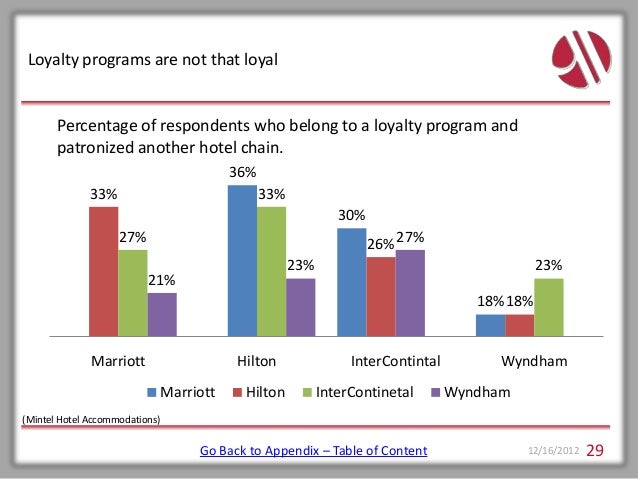Read More: The survey covered six big hotel loyalty programs: Choice Privileges, Hilton HHonors, IHG Rewards, Marriott Rewards, Starwood Preferred Guest and Wyndham Rewards. (Although Marriott bought Starwood, they’re both loyalty programs for the time being, although members have access to both.) After Wyndham, reward values ranged from roughly 9% for Marriott down to 6% for Starwood. Within those averages, though, there were some anomalies, with some hypothetical bookings delivering much more bang for a traveler’s buck (or point, as the case may be). It’s worth noting that hotel loyalty programs do have other reward benefits, and that there are other ways to earn points besides stays: Starwood’s SPG card gets marks for helping travelers rack up points, and SPG is known for the loyalty of its member base. Bottom line: If you’re already a Wyndham regular, you’d be passing up free money to not join the loyalty program.

But if you’re a member of another program and like all the perks you get — monetary and otherwise — with that program, look for ways to maximize your ability to earn points. © 2017 Time Inc. All Rights Reserved. Use of this site constitutes acceptance of our and (). Tajna Lakog Zivota Pdf Files more. Money may receive compensation for some links to products and services on this website. Offers may be subject to change without notice.
Here we have listed down 15 mind blowing Customer Loyalty Statistics that will. Hotel Customer Loyalty Statistics. Hotel Loyalty Rewards Program Satisfaction. The true driver behind a successful loyalty program is Big Data—the detailed information captured on consumers via an array of interactions across channels. Continue reading 7 Statistics on the Value of Hotel Loyalty Programs. • 83% of highly satisfied hotel loyalty program members say they “definitely will. This statistic shows the leading hotel loyalty programs in the United States as of February 2016, by customer satisfaction index score. Hilton HHonors and Marriott.

Quotes delayed at least 15 minutes. Market data provided.
ETF and Mutual Fund data provided by, Inc. Dow Jones Terms & Conditions:. S&P Index data is the property of Chicago Mercantile Exchange Inc.
And its licensors. All rights reserved.. Powered and implemented.
Have you heard this one – statistics speak for themselves? It is true for customer loyalty statistics as well. This is the time to prove what we have discussed in our previous articles – • • • First we will see few generic customer loyalty statistics and then industry specific loyalty statistics. Customer Loyalty Statistics: Acquiring a new customer is five times costlier than retaining an existing customer. (Source: ) 80% of a company’s revenue comes from just 20% of its existing customers. (Source: ) Probability of selling to an existing customer is 60 – 70% where probability of selling to a new customer is 5-20%.
(Source: ) Only 1 out of 26 unhappy customers complain. (Source: ) 33% of customers would recommend a brand that offers a quick but ineffective response.
On the other hand, 17% of customers would recommend a brand that provides a slow but effective solution. (Source: Nielsen-McKinsey) A 5% increase in customer loyalty would increase the average profit per customer by 25% – 100%. (Source: ) It takes 12 positive experiences to make up one unresolved negative experience. (Source: Understanding Customers by Ruby Newell-Legner) Customers who rate you 5 on a scale from 1 to 5 are 6 times more likely to buy from you again, compared to ONLY giving you a score of 4.8.
(Source: TeleFaction data research) 61% Americans and 54% Europeans switch brands just because of price. (Source: ) 55% of customers would pay extra for a better customer experience.
(Source: Defaqto Research) 86% of buyers will pay more for a better customer experience. But only 1% of customers feel that vendors consistently meet their expectations. (Source: ) Customer Loyalty Statistics for Marketers: Loyalty Management Market is expected to grow from USD 1.4 Billion in 2015 to USD 4.0 Billion by 2020.
(Source: ) More than 90% of companies currently have some form of customer engagement or loyalty program. Testamentul Francez Pdf Merge. (Source: ) 70% of buying experiences are based on how the customer feels they are being treated. (Source: ) 89% of customers have stopped doing business with a company after experiencing poor customer service. (Source: ) Retail Customer Loyalty Statistics: The biggest challenges retailers face regarding their loyalty programs relate to technology, strategy, financial management and people/talent. • Keeping up with the underlying technology (mobile and digital capabilities) or investing enough in technology (40%) • Keeping up with competing loyalty programs (33%) • Managing the liability and financial complexity of the program (33%) • Having enough people and the right kind of talent required for today’s loyalty programs (30%) (Source: ) (Source: ) Travel Customer Loyalty Statistics: 68% of 2016 Fliers Belong to at Least One Airline Frequent Flier Program.